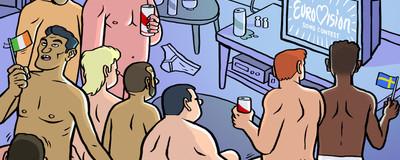How Drugs Have Been Used in Basically Every War Ever to Make Soldiers Better at Killing

An Indian security official stands outside the Taj Mahal hotel following the Mumbai 2008 attacks. Photo via SAJJAD HUSSAIN/AFP/Getty Images
In November 2008, 10 members of Lashkar-e-Taiba, an Islamic militant group, carried out a series of 12 shooting and bombing attacks, killing 164 people and wounding another 300. For almost 60 hours, in the aftermath of the destruction they had wreaked, they were able to hold off hundreds of India's best-trained special forces, before they were eventually killed or captured.
The Lashkar-e-Taiba members had received months of commando-style training. They were an elite fighting unit. But they were also high. Evidence from the scene, as well as later blood tests, found that at least some of the men had been using cocaine, LSD and steroids. It now seems clear that it was the use of drugs that allowed the group to repel a force many times their size for over two days with no food or sleep, even when some of them had life-threatening injuries.
In his new book Shooting Up, the Polish historian Lukasz Kamienski demonstrates that since warfare began, men and women have used drugs to enhance their military capabilities. Kamienski says the Mumbai attackers, whose battle fever was topped up by a steady supply of psychoactive substances, are just the latest in a long line of high combatants: from Viking berserkers driven into a trance-like frenzy by mushrooms to Inca warriors sustained by coca leaves to American Civil War soldiers hooked on morphine and the speed-fuelled Wehrmacht.
In the 1980s, the military historian John Keegan responded to the question, "Why do soldiers fight?" with three answers: "inducement, coercion, narcosis". While Keegan later decided this theory was too simple, Kamienski argues that, on top of the inducement provided by dehumanising training regimes and the coercion that sees nations force people to fight in their name, "narcosis" can be read literally: in order to kill other people, human beings need to put themselves in a different frame of mind. Drugs can make soldiers do things they otherwise never would: leave their humanity behind and becoming the fighting apparatus of an army.
"The anthropological evidence shows us that we are not warlike people," Kamienski tells me over the phone from his home in Poland. "It is very difficult to cross the line where we become able to kill fellow humans. The question is about turning a civilian into a soldier who can kill without that having too much of a psychological impact."

Shooting Up takes a chronological approach, taking us from pre-modern times to the present day. At the beginning of the book, we hear about Greek hoplites hopped up on wine, Homeric heroes swimming away from their sorrows by drinking opium and mushroom-eating Siberian tribes. But all that pales compared to the most famous mushroom-warriors, the Vikings.
Clad in bear pelt, Viking warriors were feared like few other forces in the history of war. "God save us from the Fury of the Northmen" ran the prayers of anyone who lived within striking distance. At the time it was thought that Viking warriors were seized by a fury given to them by Odin, a fury that would double their strength, remove their humanity and render them immune to pain. They bit their shields, howled like wolves and cut down anything that crossed their path. But Kamienski shows how the Vikings achieved this state, in part, by drinking Amanita mushrooms. He quotes the toxicologist Erich Hesse, who writes, "the intoxicated person imagines himself to have been changed into some animal, and the hallucination is completed by the sensation of the growing of feathers and hair."
I can't say that taking them has ever put me in the mood to lay waste to a Norwegian village, but taken in the right quantity and in the right way, mushrooms alter reality to the point where doing unnatural things (raping and pillaging) seems natural. This thinking can be seen in the combination of drugs taken by the Mumbai attackers too. Coke provided them with the energy, steroids gave them the strength and acid altered their sense of reality to the point where, like the berserkers, they could fight in frenzy.
For Kamienski, a particularly striking example of the way drugs were used to enhance the performance of soldiers comes from the Second World War. "I was completely shocked by the fact that the Wehrmacht was so heavily pumped on methamphetamine during the invasion of Poland," he tells me. "It's something you never read in history books."
 German soldiers in WWII, via
German soldiers in WWII, via
In public, the Nazi regime took a very hard line against the use of drugs recreationally, but privately, many of the Nazi elite had intimate experience with getting high. Hitler spent much of the war medicated. Goring and Goebbels both loved morphine. When the former tried to offset the effects of the morphine by taking cocaine, he became addicted to that, too.
And they also supplied drugs to German soldiers. During the 1939 invasion of Poland, Pervitin, a version of crystal meth designed to combat stress, stave off fatigue and manufacture euphoria, became the German "assault pill". With Poland conquered, the German army ordered 35 million tablets of Pervitin for the spring 1940 offensive of France.
There was little thought for the welfare of the men. The drug was used to take the Nazi war machine into overdrive. "The Nazis just wanted to make their soldiers better fighters: to fight for longer hours, to be less exhausted, to fuel the blitzkrieg even more", says Kamienski. Many German soldiers became addicted to the drug. When official supplies ran out, they would get it sent from Germany, where it was freely available. "Today I'm writing you mainly to ask for some Pervitin," wrote Hein, a 22-year old soldier stationed in Poland, to his family at home in Cologne.
The Germans weren't the only fighting force running on speed, though. Everyone was at it: the British, Americans, Japanese and even the Finns, who were , at this point, the world's largest heroin consumers. "My conclusion would be that the Second World War was fought heavily on speed or meth," Kamienski tells me.
In the 20th century, condemnation of drugs and a worry about these kinds of social effects became more pronounced and resulted in a series of prohibitive laws. Kamienski calls Vietnam "the first pharmacological war" because of the sheer quantity of drugs taken - many historians have suggested that 10-15% of American soldiers were addicted to heroin.
In the end, it is only a surprise that a wide-ranging study like Shooting Up has not been produced before. But then again, the use of drugs was an accepted part of culture until relatively recently, and so the use of them in war was hardly surprising. Today, western armies take a more hardline stance against drug use, although many American soldiers returning from Iraq and Afghanistan talked about the prevalence of "go pills" like Adderall and energy drinks, as well a wide range of protein powders and supplements to help bulk up. But through the long lens of history, that kind of small-time substance use would make a Viking chuckle.
Shooting Up, by Lukasz Kamienski, is out now
More on VICE:
Why Do the Irish Take More Weird New Drugs Than Anyone Else in Europe?
How I Sentenced Someone To Life In Prison For Selling Drugs
Laugh a Minute: We Spent a Night with Sheffield's Busiest NOS Salesman




Comments